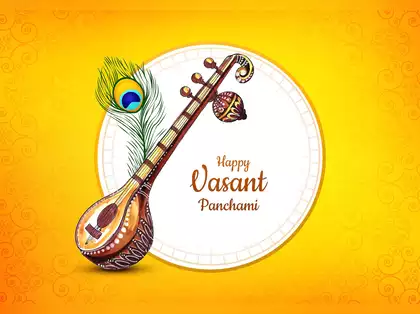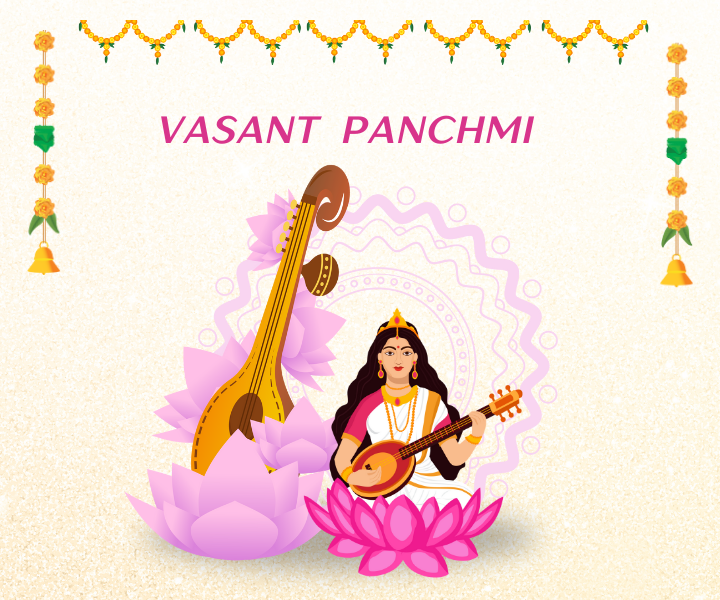Vasant Panchami, also known as Saraswati Puja, is a significant Hindu festival that marks the arrival of spring and celebrates the goddess Saraswati, the deity of wisdom, learning, and the arts. It is observed on the fifth day (Panchami) of the Hindu month of Magha, which falls in January or February. In 2025, Vasant Panchami will be celebrated with great enthusiasm on February 2, 2025.

Significance of Vasant Panchami
Vasant Panchami holds immense cultural, spiritual, and seasonal significance. It marks the transition from winter to spring and is considered an auspicious day for starting new ventures, educational activities, and artistic pursuits. The festival also signals the preparation for Holi, which occurs forty days later.
Table of Contents
Religious Significance
The festival is dedicated to Goddess Saraswati, the embodiment of wisdom, knowledge, and music. Devotees offer prayers to her, seeking blessings for academic success, intellectual growth, and creative inspiration. Schools, colleges, and educational institutions organize special pujas and cultural events to honor the goddess.
Seasonal and Agricultural Importance
Vasant Panchami is also celebrated as the onset of spring (Vasant Ritu), symbolizing renewal, fertility, and prosperity. In many regions of India, farmers begin preparing for the upcoming harvest, and fields turn vibrant with blossoming mustard flowers, which is why yellow is the dominant color of the festival.
How is Vasant Panchami Celebrated?
1. Worship of Goddess Saraswati
- Devotees wake up early, take a holy bath, and wear yellow clothes.
- Saraswati Puja is performed, where books, musical instruments, and study materials are placed near the idol of the goddess.
- Offerings such as sweets, fruits, and flowers, especially marigold and mustard flowers, are made to the deity.
- Students, artists, and scholars seek blessings for knowledge and wisdom.
2. Wearing Yellow Attire
- Yellow, symbolizing prosperity, energy, and auspiciousness, is the color of the day.
- People wear yellow clothes, prepare yellow-colored dishes like sweet saffron rice, ladoos, and khichdi, and decorate their surroundings with yellow flowers.
3. Kite Flying Tradition
- In states like Punjab, Rajasthan, and Gujarat, kite flying is a popular tradition on Vasant Panchami.
- The sky is filled with colorful kites, symbolizing the joy and freedom of the season.
4. Educational and Cultural Events
- Schools and colleges organize special Saraswati Puja ceremonies.
- Cultural programs, music recitals, poetry sessions, and art exhibitions take place to honor learning and creativity.
5. Initiation of Young Children into Education (Vidyarambh Sanskar)
- Vasant Panchami is considered the most auspicious day for a child’s Vidyarambh (initiation into learning).
- Many parents take their young children to temples for Saraswati Puja, where they are taught their first letters or words by priests and elders.

Regional Variations of Vasant Panchami Celebrations
1. West Bengal and Odisha
- In West Bengal, Saraswati Puja is celebrated with grandeur in homes, schools, and pandals.
- In Odisha, it is known as Basanta Panchami and is associated with the Jagannath Temple rituals.
2. North India (Uttar Pradesh, Punjab, Haryana)
- In Uttar Pradesh, Haryana, and Punjab, people fly kites and participate in fairs and cultural programs.
- Special feasts are prepared, and children are encouraged to take their first step toward learning.
3. Maharashtra and Madhya Pradesh
- Devotees visit temples and offer yellow flowers and sweets to the deity.
- Families prepare traditional meals and organize community gatherings.
4. Southern India (Karnataka, Tamil Nadu, Andhra Pradesh)
- While Saraswati Puja is primarily observed during Navratri, Vasant is still acknowledged with simple prayers and offerings.
Foods Associated with Vasant Panchami
1. Yellow Sweets and Dishes
- Kesari (Saffron Halwa): A popular dessert made with semolina, sugar, and saffron.
- Sweet Saffron Rice: Prepared with rice, jaggery, and saffron to enhance the festive spirit.
- Boondi and Besan Ladoos: Traditional sweets offered as prasad and enjoyed with family.
2. Khichdi
- A comforting dish made with rice, lentils, and seasonal vegetables, often prepared in North Indian households.
3. Puri and Chana
- A popular festive meal served with sweet dishes and offered as part of temple prasadam.
Astrological and Auspicious Timings for Vasant Panchami 2025
In 2025, Vasant Panchami falls on January 29, and the auspicious muhurat (timing) for performing Saraswati Puja is expected to be in the morning hours. Devotees consult astrologers for the most suitable time to begin new ventures, marriage arrangements, and important rituals.
The Connection Between Vasant Panchami and Holi
Vasant Panchami also marks the beginning of Holi preparations, especially in Braj (Mathura-Vrindavan region), where temples and devotees begin celebrating Lord Krishna’s playful Holi festivities.

Conclusion
Vasant Panchami 2025 will be a vibrant and auspicious celebration, bringing joy, wisdom, and the essence of spring. Whether through worship, cultural festivities, or indulging in traditional delicacies, the festival holds a deep spiritual and seasonal significance. As we welcome the season of renewal, let us embrace knowledge, creativity, and the blessings of Goddess Saraswati with devotion and enthusiasm.
FAQs
1. Why is yellow associated with Vasant Panchami?
Yellow symbolizes energy, prosperity, and the golden mustard fields that bloom during this time, signifying the arrival of spring.
2. Can non-Hindus participate in Saraswati Puja?
Yes, Saraswati Puja is open to everyone who wishes to seek wisdom, creativity, and academic success.
3. Is Vasant Panchami only about Saraswati Puja?
While Saraswati Puja is a major aspect, the festival also marks the arrival of spring, agricultural significance, and preparation for Holi.
4. What are the main dishes prepared for Vasant Panchami?
Traditional dishes include sweet saffron rice, khichdi, kesari, and besan ladoos, all prepared in yellow to honor the occasion.
5. How is Vasant Panchami different from Basant Panchami?
Both terms are interchangeable; “Vasant” is the Sanskrit term for spring, while “Basant” is its Hindi variant, both referring to the same festival.

This article beautifully captures the essence of Vasant Panchami, highlighting its cultural, spiritual, and seasonal significance. The detailed explanation of rituals, regional variations, and traditional foods makes it an enriching read. The connection between Saraswati Puja, the arrival of spring, and Holi preparations is well articulated, offering readers a deeper understanding of the festival’s importance. The inclusion of FAQs adds a thoughtful touch, making it accessible to all. A well-researched and informative piece—kudos to the author (Priyanka Prasad) for presenting such a vibrant celebration with clarity and depth! 🌼📖✨
Eye catching , well-written, insightful, or informative . ❤️
Wonderful information with accurate and meaningful thoughts❤️
This is a wonderfully detailed and insightful explanation of Vasant Panchami! You’ve captured the essence of the festival beautifully, from its cultural and spiritual significance to the various traditions and regional variations. I especially love how you’ve highlighted the connection between Saraswati Puja, the arrival of spring, and the preparations for Holi. The descriptions of the food and customs really bring the vibrant celebrations to life. A great read for anyone looking to understand the richness of this festival!
This is a well-researched and insightful piece,” “Your writing style is engaging and clear,” “I really appreciated the unique perspective you brought to this topic,” “The data presented is very compelling,” “This article sparked a lot of thought-provoking ideas,” or “Great analysis, very informative.”.